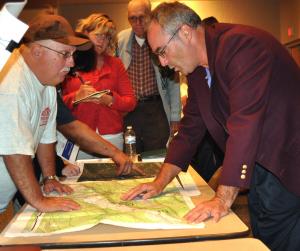Experts quizzed on rare blood disorder at Tamaqua forum
http://www.tnonline.com/node/136575
Experts quizzed on rare blood disorder at Tamaqua forum
Reported on Thursday, September 23, 2010
By DONALD R. SERFASS dserfass@tnonline.com
Two years after the discovery of a higher then normal incidence of a rare blood disease in the local area, there are still more questions than answers.
 On Wednesday, the Tri-County Polycythemia Vera Community Advisory Committee (CAC) sponsored a public health forum at the Tamaqua Area Auditorium, 500 Penn Street.
On Wednesday, the Tri-County Polycythemia Vera Community Advisory Committee (CAC) sponsored a public health forum at the Tamaqua Area Auditorium, 500 Penn Street.
The meeting, attended by 75 local residents, afforded the general public an opportunity to discuss health-oriented studies aimed at determining the extent of polycythemia vera (PV) and related myeloproliferative diseases (MPDs) and their possible link to environmental conditions in the area.
Dr. Vince Seaman of the U.S. Agency for Toxic Substances and Disease Registry presented an overview of ongoing research and introduced several research leaders to answer questions about specific studies and planned activities.
They included representatives from the University of Pittsburgh, Drexel University, Geisinger Health System, the Pa. Department of Environmental Protection (DEP), and the federal Agency for Toxic Substances and Disease Registry (ATSDR).
Much of the discussion centered on the JAK-2 mutation and screenings. JAK-2 is part of a signaling system in the body that helps tell bone marrow when to start and stop making blood cells. Most people with PV have an acquired mutation in their JAK-2, so the bone marrow makes too many blood cells. People are not born with the JAK-2 mutation.
Dr. Seaman told attendees that Geisinger Health System and Dr. Paul Roda will perform follow-up studies of JAK-2 screenings, conduct additional studies regarding prevalence of the JAK-2 genetic marker, and will work with the medical community regarding treatment practices.
Drexel University investigators will attempt to determine factors that may contribute to the PV cluster in the Tamaqua-Hazleton area by examining environmental and occupational histories of patients with PV and MPD-related disease and comparing them with those free of the diseases.
“They will do a case control study,” said Seaman, explaining that it will compare groups of people who are sick to those who are similar but not sick.
The University of Pittsburgh team is conducting a study that will compare PV rates in the Tamaqua-Hazleton area to those in four counties in the western Pennsylvania coal region to look for similarities and differences in the two areas that might provide clues to the causes of the disease.
“They have co-gen plants there. If co-gen plants have something to do with cancer then it’ll show up there, too,” said Seaman. “The University of Pittsburgh will do a study in the area to see if the number of PV cases has increased, decreased or stayed the same, “because we can’t use Cancer Registry data for that,” explained Seaman.
More screenings, tests to come
The ATSDR has plans for additional JAK-2 screenings and also will perform air and water tests.
The agency is involved in PV data collection and a population study analysis for the JAK-2 marker on a national level “to see if there’s a continuing problem or not,” said Seaman.
The Pa. DEP is doing studies at residences and has conducted water testing, which prompted questions from Merle Wertman, Tamaqua, who’s been dealing with PV for the past seven years.
 Wertman receives monthly phlebotomy treatments at St. Luke’s Miners Memorial Hospital.
Wertman receives monthly phlebotomy treatments at St. Luke’s Miners Memorial Hospital.
“They said they took samples around the Still Creek area and didn’t find anything wrong with it,” said Wertman.
But Wertman and wife Linda cannot understand why cancer is popping up along their Washington Street neighborhood.
“We have 14 cases of cancer on our block,” said Linda.
Merle said the block has about 30 homes.
Also on hand was Emery Oakes, 57, who was diagnosed with PV when blood screenings were performed one year ago.
Because of the blood thickness associated with PV, Oakes goes to the hospital and has blood drawn every six weeks.
“They take six tubes out,” he told the TIMES NEWS. He also takes 81 mg of aspirin daily. Oakes lives in the Dutch Hill section of Tamaqua with brother Michael, 52, who tested negative for PV.
 The Oakes brothers said their home was subjected to water and radon tests.
The Oakes brothers said their home was subjected to water and radon tests.
For West Penn Township resident Bill Mackey and several others, the session provided an opportunity to question the DEP about Marcellus Shale drilling.
“I want to ask them what chemicals they’re injecting into the ground for fracking. We have a cabin in Sullivan County and they’re drilling around us,” Mackey said.
The meeting was chaired by Tamaqua Mayor Chris Morrison, who urged those in attendance to spread the word about upcoming activities.
“Several of these teams will soon be conducting interviews in our area; so it is critical that we get as much information as possible.” He added: “We have a serious health threat in our area and one that may affect future generations. We need to find out why we have a cancer cluster and eliminate the cause. In the meantime we need to take good care of the patients and their families.”
Morrison credited Sen. Arlen Specter with being the impetus for the research and studies. Specter appropriated a total of $8M to investigate the blood disorder and its unusually high incidence in Carbon, Schuylkill and Luzerne counties.
Members of the volunteer CAC group vowed to continue their work in getting to the bottom of the issue.
The group has been meeting regularly and working with medical professionals, researchers, the media and the public.
“I’d like it to go faster,” said Irene Genther. “Everybody is wanting an answer.” Genther, of Nesquehoning, is a chemist with a background in education, and serves as a volunteer on the CAC board.
Like others on the board, Genther wants to find answers as quickly as possible.
